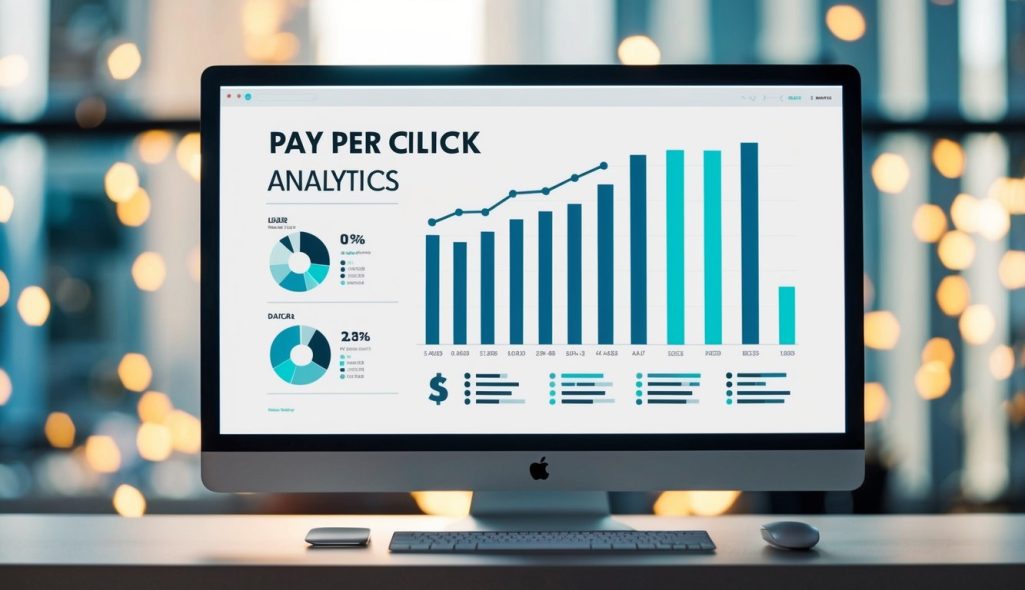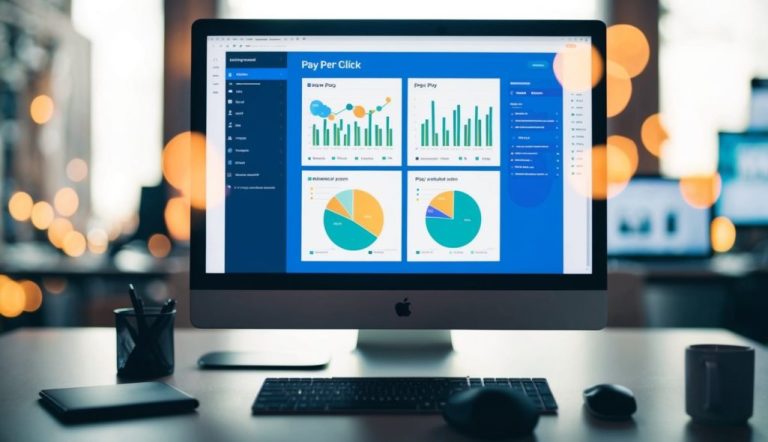Pay-per-click (PPC) analytics is an essential part of digital marketing. It helps you understand how your campaigns are performing so you can make informed decisions to grow your business. PPC analytics provides insights into what works and what doesn’t, allowing you to optimize your advertising efforts effectively.

Using metrics like click-through rates, conversion rates, and cost per click, you gain a clearer picture of your campaign’s success. This helps in adjusting strategies, setting better budgets, and improving overall ad performance. By mastering PPC analytics, you can increase both your visibility and revenue.
The right tools and techniques can enhance your PPC campaigns across various platforms. Whether you’re new to PPC or looking to refine advanced tactics, an analytics-driven approach is key to getting the most value from your digital marketing efforts.
Key Takeaways
- PPC analytics boosts digital marketing success.
- Use analytics to optimize ad performance.
- Effective strategies improve visibility and revenue.
Understanding PPC Analytics
To master pay-per-click (PPC) analytics, you need to focus on the essential metrics and their implications. By analyzing data like click-through rates (CTR) and impressions, you can make informed, data-driven decisions and improve your ad performance.
Fundamentals of Pay-Per-Click
Pay-per-click is an online advertising model in which you pay a fee each time someone clicks on your ad. This method is widely used on platforms like Google Ads. The platform displays your ads on search engine results pages or websites.
To get started, you create ads and select keywords that are most relevant to your audience. You then set a bid amount, which determines your ad’s placement. A higher bid can lead to better placement, but the quality of the ad also plays a crucial role.
Monitoring your budget is important to ensure that costs remain aligned with your goals. Setting limits and tracking spending can help avoid overspending. PPC campaigns require ongoing attention to keep them effective.
Key PPC Metrics and Terminology
Understanding PPC involves knowing key metrics. The first one is the click-through rate (CTR), which measures the percentage of people who click on your ad after seeing it. A higher CTR indicates that your ad is appealing.
The next metric is impressions, which refer to how often your ad is shown. A high number of impressions with a low CTR might suggest that the ad needs improvement. Lastly, the cost-per-click (CPC) shows how much you pay on average for each click.
Quality Score is also pivotal. It assesses the relevance and quality of your ads. A high Quality Score can lead to lower CPC and better ad placements. Using these metrics helps you understand the impact of your advertising efforts.
Importance of Analyzing PPC Data
Analyzing data is essential for optimizing your PPC campaigns. This involves looking at various metrics to see what’s working and what isn’t. By evaluating CTR, impressions, and other statistics, you can refine your strategies.
Making data-driven decisions ensures that you focus on what brings results. Tracking performance regularly helps identify trends and adjust campaigns accordingly. With the right approach, you increase the chances of achieving your advertising goals.
Utilizing tools and resources available can give you deeper insights into your campaigns. Aim to constantly analyze and adapt your PPC strategy to enhance effectiveness and return on investment.
Setting Up PPC Campaigns
In setting up successful PPC campaigns, it’s crucial to develop a structured strategy. Begin by conducting thorough keyword research to identify high-impact search terms.
Craft compelling ad copies that attract attention and select effective targeting options to reach your desired audience.
Developing a Structured PPC Strategy
To start, establish clear goals for your campaign. Decide what you want to achieve, whether it’s increasing website traffic, generating leads, or boosting sales.
Break down your campaign into smaller ad groups. Each ad group should focus on a specific theme or product. This allows you to create targeted ads and improve relevance.
Identify your budget and bidding strategy. Choose a daily budget that aligns with your goals and market conditions. Decide between manual or automated bidding based on your level of experience and control.
Keyword Research and Selection
Effective keyword research is the foundation of any PPC campaign. Use tools like Google Keyword Planner to find high-performing keywords that match user intent. Look for keywords with a good balance of search volume and competition.
Incorporate a mix of broad, phrase, and exact match keywords to cover different user queries. This broadens your reach while maintaining relevance.
Don’t forget about negative keywords. These help filter out irrelevant traffic, saving your budget from clicks that won’t convert. Regularly update your negative keyword list as you identify non-performing terms.
Creating Compelling Ad Copies
Your ad copy is what users see, so make it stand out. Focus on crafting attention-grabbing headlines and persuasive descriptions. Highlight unique selling points and include clear calls to action.
Ensure each ad aligns with the corresponding ad group. This boosts ad relevance and improves quality scores. High quality scores can lower your cost-per-click and improve ad positioning.
Use ad extensions to provide more information, like site links or contact details. Extensions can increase your ad’s visibility and encourage more clicks by giving users extra reasons to choose you.
Targeting and Retargeting Options
Precision in targeting is key to reaching the right audience. Start by defining your audience’s demographics, such as age, gender, and location.
Utilize interest targeting to reach users based on their online behavior and preferences. This strategy can align your ads with users who are more likely to be interested in your products or services.
Consider retargeting to re-engage users who’ve interacted with your site before. Platforms like Google Ads offer retargeting options to remind users of your brand and lead them back to convert.
Adjust your targeting settings based on performance data. Analyze which segments yield the best results and allocate more budget to these high-performing groups.
Optimizing Landing Pages for PPC
Making your PPC landing pages effective is key to increasing conversions and improving your quality score. You should focus on designing for conversion and enhancing the landing page experience to meet these goals.
Designing for Conversion
Your landing page design needs to focus on turning visitors into customers. Start by creating a clear and compelling headline. This should match the message of your ad to avoid confusing visitors.
Use visual elements like images and videos to support your message. These elements should not distract from the main call to action (CTA), which needs to be prominent and easy to find.
Consider using bullet points to highlight key benefits or features. This format helps readers quickly understand what you offer. Lastly, ensure that the page is mobile-friendly. With many users accessing content on smartphones, mobile optimization is essential for capturing a wider audience.
Landing Page Experience and Quality Score
The landing page experience is a significant factor in your quality score, which influences your ad rankings and costs. For a good experience, ensure fast load times. A slow loading page can increase bounce rates and hurt your score.
Content relevancy is equally important. Your landing page content should align with the ad’s keywords and messaging. Google measures how well the content meets user expectations, so keeping messages consistent is key.
Navigation should be simple. Avoid unnecessary links or distractions that might lead users away from completing the desired action. By focusing on these aspects, you can maintain a high-quality score and improve conversion rates.
Measuring and Analyzing Performance
Effective pay-per-click (PPC) management involves understanding performance through specific analytics. It’s essential to focus on the metrics that matter most, such as conversions, cost efficiency, and the return on investment (ROI). Utilizing the right tools can significantly enhance your analysis.
Tracking Conversions and ROI
Understanding conversions is crucial for analyzing PPC campaigns. Conversions can range from sales, sign-ups, or any action valuable to your business. Tracking these allows you to calculate the return on ad spend (ROAS) and ROI, which shows how much value each campaign generates compared to its cost.
Use data to assess which keywords and ads lead to the most conversions. Ensure you’re not just counting every click; focus on those that lead to a desired action. Employ conversion tracking tools like Google Analytics to monitor how well your campaigns turn prospects into customers. This will help you adjust your strategy to optimize for conversions and increase ROI.
Understanding Cost Metrics
Cost metrics, such as cost per click (CPC) and cost per conversion, give a clear picture of how much you’re spending. CPC tells you the price of each individual click on your ad, while the cost per conversion shows how much you pay to get someone to complete a desired action.
Keeping these costs low while maintaining quality traffic is key. Begin by assessing which keywords incur high costs but yield few conversions. Then, reallocate your budget to better-performing keywords. You need to constantly balance your spending to ensure that you’re getting the maximum return for the dollars spent.
Evaluating Key Performance Indicators
Key Performance Indicators (KPIs) in PPC campaigns include metrics like click-through rate (CTR), conversion rate, and ROI. High CTR indicates that your ads are appealing and effectively driving traffic. The conversion rate shows how well this traffic turns into valuable actions.
Assess these KPIs regularly to improve your campaign performance. Falling CTR or conversion rates suggest you need to refine your ad copy or landing pages. By regularly evaluating these metrics, you can make informed decisions for optimization, driving both efficiency and effectiveness.
Utilizing PPC Tools for Enhanced Analysis
PPC tools are indispensable for in-depth analysis and optimization. These tools can range from comprehensive analytics platforms like Google Analytics to specialized solutions like SEMrush or Improvado’s PPC analysis tools.
Leverage these tools to gather, visualize, and interpret data effectively. They help automate tracking and provide insights into trends and performance metrics. Use tools to perform A/B testing on ad variations and conduct keyword research. The right PPC tools empower you to streamline your strategy, reduce costs, and boost conversions efficiently.
Advanced PPC Analytics Techniques
In the world of PPC analytics, understanding your competition, experimenting with campaign variables, and tapping into audience data can significantly boost your campaign performance. These advanced techniques can help optimize your strategies for better results.
Competitive Analysis in the PPC Landscape
Conducting a competitive analysis involves monitoring your competitors’ ad strategies. By understanding their keyword strategies, ad placements, and conversion tactics, you can gain insights into market trends and gaps. This helps you position your campaigns more effectively.
Use tools like SEMrush or SpyFu to track competitor keywords and ad copies. Analyzing their strengths and weaknesses allows you to adjust your strategy, bid on similar keywords, or find unique niches they haven’t explored. Keeping an eye on competitors ensures you stay competitive while enhancing your PPC approach.
A/B Testing for PPC Campaigns
A/B testing is essential in PPC for comparing different versions of ads to see which performs better. Choose elements to test, like headlines, images, or calls-to-action, and observe how changes impact your goals. Run tests under similar conditions to ensure accurate comparisons.
Start with a hypothesis about what could improve your campaign. Modify one element at a time to clearly see its effect. Analyze the results with clear metrics like click-through rates or conversion rates. Continuous testing helps you refine your ads, ensuring your campaigns are constantly evolving to attract more clicks and conversions.
Leveraging Audience Behavior Data
Audience behavior data reveals how users interact with your ads and site. Studying this data helps tailor your marketing efforts to meet audience needs and preferences. Utilize tools like Google Analytics 4 to track user behavior and gather insights.
Analyze which audience segments convert the most. This information helps create targeted ads that resonate better with specific groups. Adjust your campaigns based on user demographics, interests, and past interactions to enhance relevance and engagement.
PPC Analytics on Different Platforms
PPC analytics provide critical insights into advertising performance across various platforms. This information helps you optimize ad spend and improve return on investment.
Google Analytics for PPC
Google Analytics is a powerful tool for tracking the performance of your Google Ads campaigns. It integrates easily with your ads to show metrics like clicks, impressions, and conversion rates. You can see real-time data, helping you adjust campaigns quickly.
Advanced features allow you to track user behavior on your website after they click an ad. This includes page views, session duration, and bounce rates. By linking your Google Ads and Analytics accounts, you create a comprehensive view of the customer’s journey from ad click to conversion. This data is essential for making informed decisions in campaign management.
Analytics for Social PPC: Facebook and LinkedIn Ads
Facebook Ads offer a robust analytics dashboard that provides insights into ad reach, engagement, and conversion. You can pinpoint which demographics are interacting with your ads, allowing for targeted adjustments. This is crucial for effective audience segmentation and ad spending.
LinkedIn Ads also provides detailed analytics. You can track metrics like click-through rates and engagement levels. LinkedIn’s audience insights help you understand the professional backgrounds of users engaging with your ads. Adjusting your campaigns based on these analytics optimizes performance on business-focused social platforms.
E-commerce PPC: Amazon Ads
Amazon Ads provide a unique set of analytics tailored to e-commerce platforms. With metrics like sales attribution, keyword performance, and return on ad spend, you can focus on driving sales and increasing visibility. You have access to tools that show which keywords are converting, enabling you to refine your bidding strategies.
One valuable feature is the ability to see how shoppers interact with your product listings after clicking an ad. This helps you understand customer preferences and optimize product detail pages. Amazon’s robust PPC analytics ensure that you can make strategic decisions that enhance the effectiveness of your ad campaigns on one of the largest e-commerce platforms in the world.
Applying PPC Analytics to Optimize Campaigns
Using PPC analytics can significantly enhance the success of your campaigns. By focusing on real-time data, historical data, and predictive analysis, you can adjust campaigns to improve performance and achieve better results.
Real-time Data for Immediate Adjustments
Real-time data allows you to monitor your PPC campaigns as they occur. This instant access to information is critical for making quick decisions.
For example, if you notice that a specific keyword isn’t performing well, you can immediately tweak your bids or pause the keyword.
Monitoring metrics like clicks, impressions, and conversion rates can help you react to sudden changes. By using a PPC dashboard to display this data, you’ll see your campaigns’ current performance in one place. This allows you to stay proactive and ensure your budget is spent wisely.
Adjustments made in real-time can prevent wasting resources on underperforming elements. This means you can make data-driven decisions to enhance overall effectiveness while gaining an edge over competitors who might not react as swiftly.
Historical Data for Long-term Strategy
Historical data provides insight into how your past campaigns have performed. This data is invaluable for identifying trends and patterns that can inform your long-term strategy.
Knowing which keywords and ads have historically driven conversions allows you to plan better for future campaigns.
Metrics such as conversion rates and cost-per-click give you a clearer picture of what has worked before. These insights can help shape your future campaigns to maximize results.
It’s important to regularly review this data to spot opportunities and areas needing improvement.
You can use historical data to benchmark current campaigns against previous ones. Understanding successes and failures helps refine your approach and allocate your budget more effectively for sustained success.
Predictive Analysis for Future Campaigns
Predictive analysis uses existing data to forecast future campaign performance. This approach helps you anticipate trends and adjust strategies accordingly.
By leveraging predictive tools, you can create models based on past campaign data and probable future scenarios.
Insights gained from predictive analysis can guide budget allocation and bidding strategies.
For example, if a particular campaign is likely to perform well during a specific season, you can prepare by adjusting bids and budgeting to maximize return.
Incorporating predictive analysis in your PPC strategy enables more informed decision-making. This approach helps you stay ahead of trends and optimize future campaigns for better outcomes.
Scaling and Expanding PPC Efforts
When looking to scale and expand your PPC efforts, you’ll want to focus on strategic growth within advertising to maximize returns. Using different platforms and techniques can help you reach new audiences while improving existing campaign performance.
Growth Strategies in PPC Advertising
To effectively grow your PPC campaigns, starting with a solid foundation is important. Begin by setting clear goals and targets for what you want to achieve.
Utilize metrics like conversion rates and cost per acquisition to measure success.
One effective strategy is to incrementally increase your budget. This allows you to test the waters before committing significant resources.
Prioritize high-performing keywords and ads, ensuring that your spending aligns with your objectives. Experiment with different ad formats to discover what resonates best with your audience.
For example, trying out video ads might provide a new pathway for engagement.
Diversifying PPC Platforms and Techniques
Diversifying the platforms you use can unlock different audiences and opportunities. Consider expanding beyond Google Ads to platforms like Bing or social media networks such as Facebook and Instagram. Each has its own strengths and attracts different types of users.
Exploring various techniques can also enhance your campaigns. You might use remarketing to re-engage users who previously interacted with your website.
Employing A/B testing can reveal valuable insights into which ads perform better, allowing you to optimize accordingly.
Review and adjust your strategy regularly to adapt to new trends and ensure that your PPC efforts are both diverse and effective.
Challenges and Solutions in PPC Analytics
Pay-Per-Click (PPC) advertising involves navigating large amounts of data to improve ad performance. Understanding complex data sets, overcoming analysis paralysis, and ensuring data accuracy are vital steps for successful PPC management.
Navigating Complex PPC Data
Handling PPC data can be daunting. You’ll encounter numerous metrics like clicks, impressions, and cost-per-click. Each metric provides insights that, when combined, help optimize campaigns.
You need to identify which metrics directly impact your goals and prioritize those.
Visual tools like charts and tables simplify this complexity. For instance, Google Analytics can visualize data trends, making it easier to identify patterns.
By focusing on key performance indicators (KPIs), you can effectively manage PPC data and make informed decisions. Regularly reviewing and refining these priorities ensures that your efforts are aligned with campaign goals.
Overcoming Analysis Paralysis
Analysis paralysis occurs when faced with too much data, making decisions difficult. Instead of being overwhelmed, set clear objectives for your PPC campaigns. This narrows your focus to relevant data points.
Structured approaches and tools can assist in breaking down complex information into manageable parts.
Using PPC management platforms can streamline data analysis by providing tailored reports that focus on your specific goals.
By setting defined timelines for reviewing data, you maintain momentum and avoid endless analysis. Creating a checklist of essential data to evaluate can also help maintain a clear direction.
Ensuring PPC Analytics Accuracy
Accuracy in PPC analytics is crucial for effective decision-making. Inaccurate data can lead to poor strategies and wasted resources.
Regular data audits should be part of your process to ensure data reliability.
Use tools that track click patterns to detect any unusual activity. For example, tools like Google Analytics can identify fraud patterns.
Implementing robust tracking methods ensures that your data remains consistent across platforms. Correct tagging and regular verification help maintain both accuracy and trust in your data.
Creating consistent review routines safeguards the integrity of your PPC campaigns, ultimately leading to better returns on your investment.
Frequently Asked Questions
Understanding Pay-Per-Click (PPC) analytics involves knowing how to measure campaign success, implement effective strategies, and use tools like Google Analytics. It’s essential to track performance indicators and conversion rates while considering cost factors.
How do you effectively measure the success of a Pay-Per-Click campaign?
To measure success, focus on metrics like click-through rates (CTR), conversion rates, and return on ad spend (ROAS). These indicators show how well your ads perform and how efficiently your spend translates into revenue.
What are some best practices for implementing a PPC analytics strategy?
Start by defining clear goals and objectives.
Regularly analyze data to identify trends and make adjustments.
A/B testing different ad formats and targeting options can improve campaign performance. Continuous optimization is key to a successful strategy.
What are the key performance indicators to track in PPC advertising?
Key performance indicators (KPIs) include CTR, cost per conversion, and quality score. These metrics help you gauge the effectiveness of your ads in engaging users and achieving desired outcomes.
How can Google Analytics be used to optimize a PPC campaign?
By linking your Google Ads account with Google Analytics, you can track user behavior on your site. This allows you to identify which keywords and ads lead to conversions and make data-driven decisions to optimize your campaigns.
What factors influence the cost per click in digital advertising?
Several factors influence cost per click, including competition for keywords, ad relevance, and quality score. Ensuring your ads are relevant and of high quality can help manage costs effectively.
What methods are recommended for tracking and improving PPC conversion rates?
A/B testing is recommended for comparing different ad elements and landing pages. Regularly review analytics data to pinpoint areas for improvement. Adjusting targeting and keyword strategies can also enhance conversion rates.





